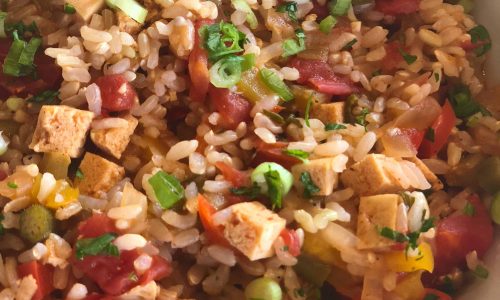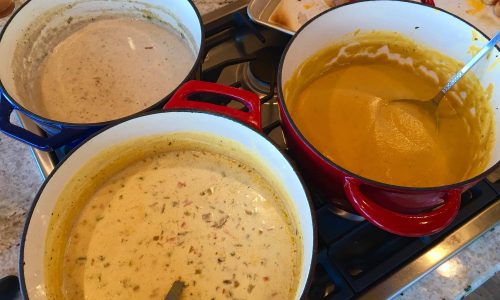
Charcuterie traditionally referred to the production of pork-based pates, terrines and galantines, but now includes similar products made with game, poultry, fish and shellfish. The study of charcuterie is quite extensive and could take an entire semester easily, so our brief class barely scratched the surface. We also studies the cheeses and condiments during this class. Chef Loy lectured on the history of sausage making and how they are made. Although we didn’t make our own sausage due to time constraints we were given the opportunity to create a sausage blend using already freshly ground pork. I learned many new terms such as forcemeat (a preparation made from uncooked ground meats, poultry, fish or shellfish that is seasoned and emulsified with fat), panada (something other than fat that is added to a forcemeat to enhance smoothness–such as white bread soaked in milk), and mousseline (light, airy forcemeat made with fish or poultry). For the evening’s assignment we rotated to five stations to learn how to make the following: 1) Pate, forcement, or mousseline 2) Cheese (we drew a slip of paper with the cheese we had to make–I drew queso fresco 3) Sausage 4) Condiments and 5) our own dish made with things we made at the other stations.
I started out by making sausage. I added feta cheese, chopped spinach, garlic, red pepper and salt and pepper to pork. The sausage patty was then fried in olive oil. This was very tasty and I was pleased. The condiment station was also a good experience. I made oven dried tomatoes with olive oil, garlic, salt and pepper and thinly sliced cucumbers in wasabi pickling liquid. Both were good, but the cucumbers could have used a little stronger wasabi flavor. I made my queso fresco which was fairly simple–cook salted milk with a little cider vinegar until a curd forms, then strain it. It was quite interesting to see the cheese forming as I stirred the milk. Someone even used my queso fresco on their final dish. My worst experience was with the mousseline. I chose to use fish and shrimp, processed in the food processor, then added cream and strained it. I added too much cream so it was too thin. Yuck! Fortunately my final dish was better. I used my feta spinach sausage, added slices of oven dried tomato and some sauteed spinach. It was very flavorful, however I overcooked the spinach (while waiting for my sausage to cook all the way through). All in all it was a very informative and fun class (except for the stress of making that awful mousseline!)


I started out by making sausage. I added feta cheese, chopped spinach, garlic, red pepper and salt and pepper to pork. The sausage patty was then fried in olive oil. This was very tasty and I was pleased. The condiment station was also a good experience. I made oven dried tomatoes with olive oil, garlic, salt and pepper and thinly sliced cucumbers in wasabi pickling liquid. Both were good, but the cucumbers could have used a little stronger wasabi flavor. I made my queso fresco which was fairly simple–cook salted milk with a little cider vinegar until a curd forms, then strain it. It was quite interesting to see the cheese forming as I stirred the milk. Someone even used my queso fresco on their final dish. My worst experience was with the mousseline. I chose to use fish and shrimp, processed in the food processor, then added cream and strained it. I added too much cream so it was too thin. Yuck! Fortunately my final dish was better. I used my feta spinach sausage, added slices of oven dried tomato and some sauteed spinach. It was very flavorful, however I overcooked the spinach (while waiting for my sausage to cook all the way through). All in all it was a very informative and fun class (except for the stress of making that awful mousseline!)



I included a couple extra photos here. Eric with his very tasty puff pastry and breakfast with his sausage, egg, and apple vinaigrette. I also made a pork tenderloin with roasted carrots and asparagus to take to someone recovering from surgery. It turned out really great. Lastly, one of my biggest fans, my granddaughter Kyndal who came to have Sunday brunch when I was cooking a couple weeks ago. Now she wants her own chef hat and coat. (Of course I’ll get her one.)


